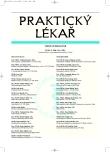Clinical aspects and neurobiology of Alzheimer’s disease
Vztah klinického obrazu a neurobiologie Alzheimerovy nemoci
Alzheimerova nemoc (AN) je tichá epidemie postihující seniory, jedno z nejčastějších základních onemocnění vedoucích ke smrti dospělé populace. Možná a pravděpodobná diagnóza AN je klinická. Vychází z mezinárodních kriterií. Definitivní diagnóza AN je neuropatologická. Při diagnóze raných vývojových stádií AN je nutné mít na mysli mírnou poruchu poznávacích funkcí. Ranou formu AN charakterizuje nástup do 65 let věku, pozdní formu 65–85 roků, velmi pozdní ve věku 85 a více let. Familiární formy AN představují 5–10 % všech případů, sporadická forma 90–95 %. Molekulární patogenezi AN řeší „baptisté“ hypotézou amyloidové kaskády. „Tauisté“ se zaměřují na patologii tau-proteinu. Obě teorie mají společné jmenovatele. V patogenezi AN se dále uplatňují apoptóza neuronů, zánětlivé mechanismy a cévní postižení. Klinické příznaky AN, poruchy recentní, později sémantické paměti, prostorové orientace, emotivity, jazyka a řídících funkcí v jisté míře korelují s distribucí neuronálních klubek a neuritických plak.
Klíčová slova:
Alzheimerova nemoc, epidemiologie, patogeneze, vztah mozku a chování.
Authors:
F. Koukolík
Authors‘ workplace:
Primář: MUDr. František Koukolík, DrSc.
; Národní referenční laboratoř prionových chorob
; Fakultní Thomayerova nemocnice s poliklinikou, Praha
; Oddělení patologie a molekulární medicíny
Published in:
Prakt. Lék. 2007; 87(8): 474-478
Category:
Various Specialization
Overview
Alzheimer’s disease (AD) is a silent epidemic involving the elderly and is one of most frequent causes of death in the adult population. Probable and possible diagnosis of AD is a clinical one and is based on international criteria. The definitive diagnosis of AD is neuropathological. The diagnosis of mild cognitive impairment has a fundamental role in the differential diagnosis of evolving AD. Early form AD concerns the population up to 65 years, late form AD affects individuals between 65 and 84 years old, and very late form AD occurs in the 85+ population. Familiar forms of AD constitute 5–10 % of all cases, whilst sporadic forms account for the remaining 90–95%. The amyloid cascade hypothesis is a fundamental hypothesis for the so-called “Baptists”. “Tauists” focus on the metabolism of tau protein. Both hypotheses share some common factors. The pathogenesis of AD involves apoptosis of neurons, inflammatory mechanisms and vascular pathology. Signs and symptoms of AD (e.g. impairment of recent episodic and then of semantic memory, special disorientation, altered emotivity, language and executive functions) are in some correlation with the distribution of neuronal tangles and neuritic plaques.
Key words:
Alzheimer’s disease, epidemiology, pathogenesis, brain-behaviour correlation.
Labels
General practitioner for children and adolescents General practitioner for adultsArticle was published in
General Practitioner

2007 Issue 8
- Metamizole vs. Tramadol in Postoperative Analgesia
- Metamizole at a Glance and in Practice – Effective Non-Opioid Analgesic for All Ages
- Memantine in Dementia Therapy – Current Findings and Possible Future Applications
- Memantine Eases Daily Life for Patients and Caregivers
- Possibilities of Using Metamizole in the Treatment of Acute Primary Headaches
Most read in this issue
- Interstitial lung diseases - survey, differential diagnosis and methods of investigation
- Extrinsic allergic alveolitis
- Head and facial pains brought on by ENT diseases
- Plant dermatitis The author aims to provide
